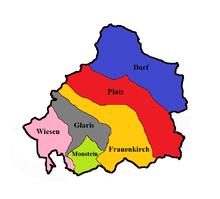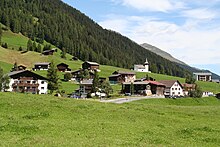Davos Frauenkirch
Davos Frauenkirch is a district (until the end of 2018 a parliamentary community ) in the Davos landscape . It lies between Davos Platz and Davos Glaris in the Landwasser Valley and, with 57.52 km², was the third largest of the six Davos parishes in terms of area. On January 1, 2015, Frauenkirch had 429 residents. The scattered Walser settlement is named after the Church of the Dear Lady .

geography
The place is at 1505 m above sea level. M. between Davos Platz and Davos Glaris. The distance to Davos Platz is around four kilometers. The houses of the settlement are scattered on the mountain slopes and along the road in the Landwassertal. The Landwasser river flows through Frauenkirch from Davos Platz in a southerly direction. The Sertigbach flows into the Landwasser at Frauenkirch .
The Frauenkirch parliamentary group also includes the neighborhood Sertig in the Sertig Valley , the Stafelalp and the Wildboden, a plateau created by a moraine at the western end of the Sertig Valley.
church
The little church "To the dear woman" dates from the pre-Reformation period. It was built around 1350 and a tower was added in 1470. In the avalanche winter of 1602/1603 the church was almost completely destroyed by an avalanche. In 1603 it was rebuilt and provided with the characteristic avalanche splitting wedge on the mountain side . Since then it has withstood all avalanches. Next to the church is the small village cemetery, which is surrounded by a low stone wall painted white.
There is a reformed rectory in Frauenkirch.
school
During the Great Depression, a new schoolhouse was built in Frauenkirch in 1936 as part of a job creation program following the demolition of the old schoolhouse and an architectural competition. It was built according to the plans of the Davos architect Rudolf Gaberel in wood construction with a solid substructure and clad on the outside with wooden shingles. The German artist Ernst Ludwig Kirchner , who lived in Frauenkirch for more than twenty years and was very close to his adopted home, received the order from the Davos community for a supraporte above the main entrance portal of the school building. His relief made of pine wood entitled Teacher Florian Bätschi with school children was Kirchner's first and only public commission.
The new school building was inaugurated on October 18, 1936 with a large public participation. Kirchner described the inauguration ceremony in a letter to German art collector Carl Hagemann as follows:
“Yesterday was the inauguration of the new school building. A party with singing, dancing and talking, and afterwards a pub that I haven't seen or even participated in for decades. Everyone ... sat in the "Post", the Small Council, the Landammann, the farmers, all united and friendly. ... "
For a long time it was a tradition in Frauenkirch that at the beginning of a new school year the girls and boys depicted on the wooden relief were "baptized" by the school beginners . The schoolhouse is now a listed building. The primary school Davos Frauenkirch is still housed in the building.
Ernst Ludwig Kirchner
The German painter Ernst Ludwig Kirchner settled in Frauenkirch after moving to Switzerland in September 1918. At first he lived in a house belonging to the court group In den Lärchen , which he artistically redesigned. From 1923 on he lived and worked for fifteen years in a farmhouse in Frauenkirch-Wildboden, the so-called "Wildbodenhaus". He committed suicide in this house in June 1938 and was buried in the nearby forest cemetery.
In numerous works of art and photographs by Kirchner that were created during these twenty years, the place itself, the landscape surrounding it or its inhabitants can be seen. Examples include the woodcut “Frauenkirch” (1918), the oil painting “Frauenkirch im Winter” (1918/19) and the watercolor “Frauenkirch im Herbst” (1920) from the early years .
Forest cemetery

The Davos forest cemetery , which also belongs to Frauenkirch , was also built according to plans by the architect Rudolf Gaberel. The graves of important Davos personalities are located in this larch forest , which is surrounded by a dry stone wall . Ernst Ludwig Kirchner and his partner Erna Schilling Kirchner also found their final resting place here.
In 1930 a small Jewish cemetery was laid out in part of the forest cemetery .
economy
Frauenkirch has several farms as well as several restaurants and inns. There is a hotel in the Sertig Valley. The industrial zone Sandgruoba with various companies in the construction industry is located in the immediate vicinity of Landwasser . Furthermore, there are small trading and commercial enterprises, a riding school and a painter's studio with a sales gallery in Frauenkirch.
traffic
The place is connected to the Kantonsstrasse and the Davos – Filisur line of the Rhaetian Railway . In addition, a public bus line connects Frauenkirch with the other parliamentary groups.
Art trail
Frauenkirch since 2009, leads sculptures - hiking up to Stafelalp. The exhibited works are exchanged every year in September and replaced by new sculptures that were created at the annual Davos Sculpture Symposium .
Attractions
Web links
- Website of the Davos Frauenkirch parliamentary group
- Information about Frauenkirch on the Davos community website
Individual evidence
- ↑ a b Website of the Davos community: Davos in numbers , gemeindedavos.ch, accessed on November 7, 2016.
- ↑ Article Bergschulhaus Davos-Frauenkirch, Rud. Gaberel, architect BSA, Davos . In: Das Werk: Architektur und Kunst = L'oeuvre: architecture et art , Vol. 25, 1938, Issue 2, e-periodica.ch, accessed on November 7, 2016, .pdf (with photos and drawings).
- ^ Letter from Ernst Ludwig Kirchner to Carl Hagemann, October 19, 1936
- ↑ a b Erhard Göpel: The restored Kirchner house in Davos . In: Das Werk: Architektur und Kunst = L'oeuvre: architecture et art , Volume 51, 1964, Issue 12, e-periodica.ch, accessed on November 7, 2016, .pdf (with photos and drawings).
- ↑ Information about the Davos Frauenkirch elementary school , schuledavos.ch, accessed on November 7, 2016.
- ^ Biography Ernst Ludwig Kirchner , Kirchner Museum Davos, kirchnermuseum.ch, accessed on November 7, 2016.
- ↑ Sculpture Path Frauenkirch Davos – Stafelalp ( Memento of the original from April 24, 2017 in the Internet Archive ) Info: The archive link has been inserted automatically and has not yet been checked. Please check the original and archive link according to the instructions and then remove this notice. , skulpturenweg-davos.ch, accessed on November 7, 2016.
Coordinates: 46 ° 46 ' N , 9 ° 48' E ; CH1903: seven hundred eighty thousand three hundred and one / 182458




